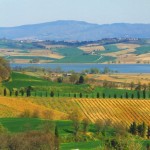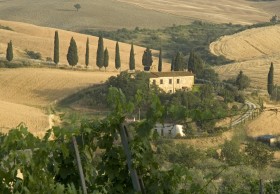When you take the Strada delle Crete, the road that leads down from Siena towards the south, the last strip of Tuscany before Umbria, you need to drive carefully. Every 100 metres or so there will be somebody who has pulled their car to a halt along the side of the road, and is taking photographs, totally enrapt, unaware of anything else.
Of course, tourists and travellers from all over the world have been crisscrossing Tuscany for centuries, but this more recent phenomenon begs the question of whether this desire to bring home a memory of this land is merely an example of the, very common, compulsion to collect beautiful images, or whether it is the result of a deeper intuition.
Could it be that the traveller discerns something of how this landscape has become so beautiful? How the people of this land have consciously moulded, protected and cared for it.
This countryside reveals its history, a history that is carved into its curves and apparent in its hills, in its fields, in the olive trees and cypresses. The cypress trees have become a symbol of Tuscany, although they were originally brought over from the Middle East. They still seem to beckon to us, evoking lost memories and celebrating a forgotten way of life.
The Strada delle Crete winds through gently rolling hills. The beauty belies the challenges of cultivating this poor soil: the grand, now empty, houses and a few hardy trees, casting no shadow, are the only remnants of the souls who once walked here. The seasonal changes of the landscape are sudden and stark. From light grey to burnt umber, from lush green to shimmering gold.
At the end of this road the city of Montepulciano appears before us. It climbs the steep hillside and stretches out over the top of the hill, dividing the Val d’Orcia from its neighbour, the Val di Chiana, a few dozen kilometres away.

The Val di Chiana is completely different, greener, bordered by lakes and mountains. Visitors continue to take photographs here, astonished by the contrast. From the higher hills the walled towns continue to look down over the valley, as if protecting the territory they have administered autonomously for so many centuries.
This land is generous, its vineyards and olive groves among the most famous in the world. Life here is more intense, and the countryside full of houses, in testament to the density of the population that once lived here, in the not so distant past. The Val di Chiana is the site of an immense hydraulic engineering project that was completed just over 200 years ago – a project that was four centuries in the making: the reclamation of the marshland that covered the entire area. This landscape, too, is the result of a project, a challenge, and human toil.

The lakes that border it are the remnants of this immense humid area. This land, too, reveals its history, captivating anyone passing through: it is not only the natural beauty that inspires such passion, but the histories of women and men, of their tenacity and creativity.
Perhaps this is what they feel, the visitors who are compelled to put images of this part of Tuscany in the virtual suitcase of their experiences. It is worth taking the time to travel these roads slowly, with eyes and ears open. There are endless ways to appreciate this landscape: just go beyond the superficial, and leave behind the rush and bustle of our everyday lives.
by Silvia, teacher in ilsasso.com, Montepulciano, Tuscany


